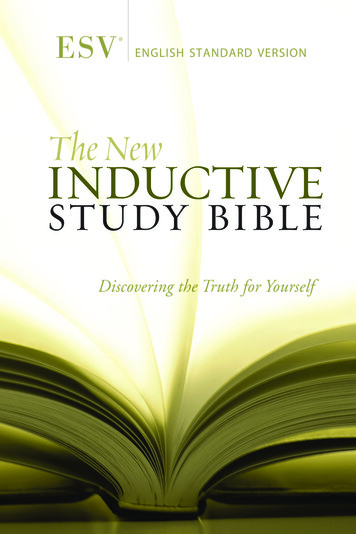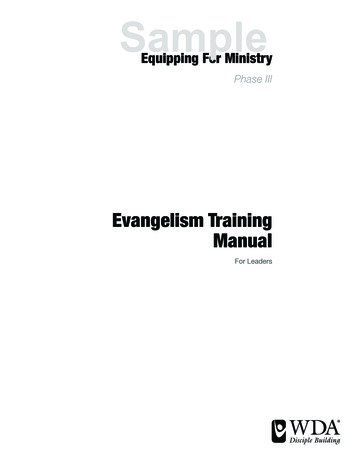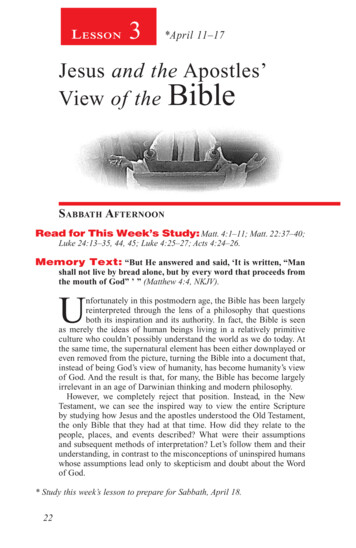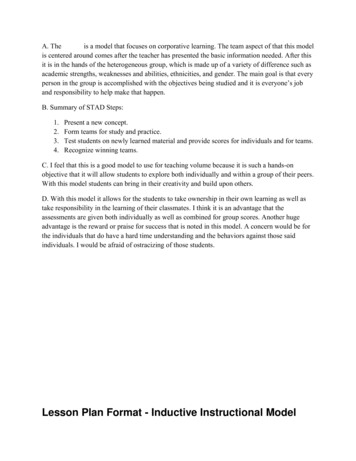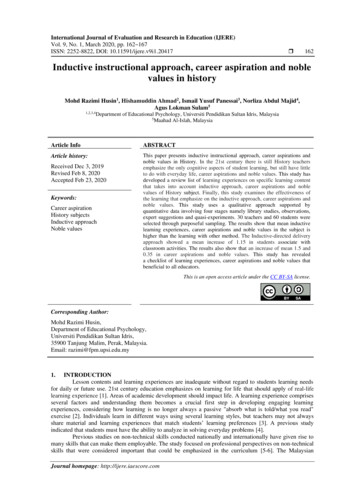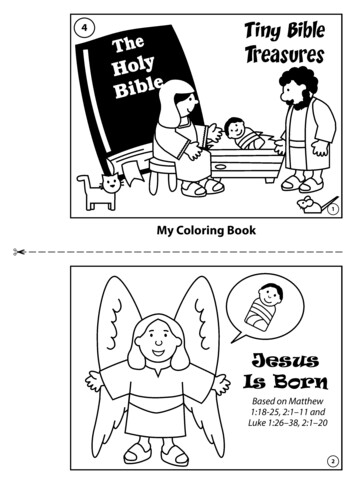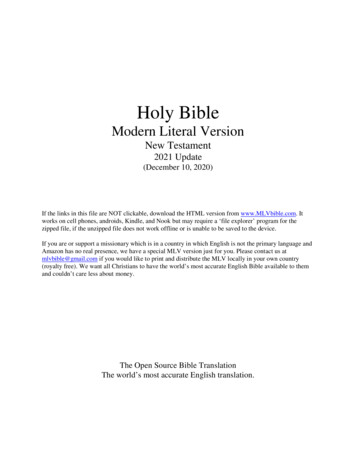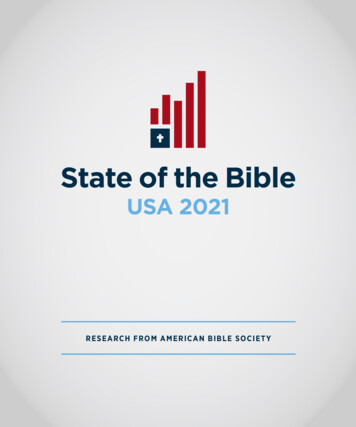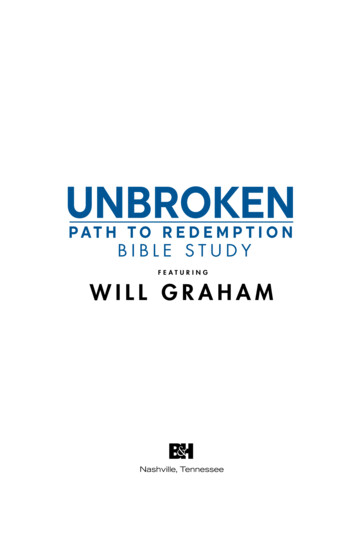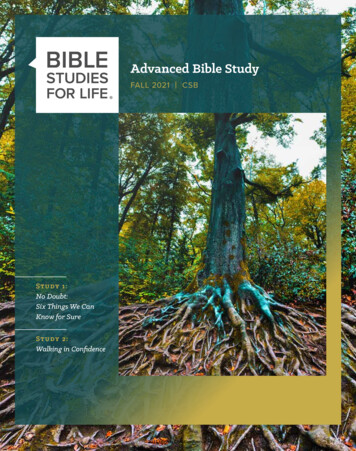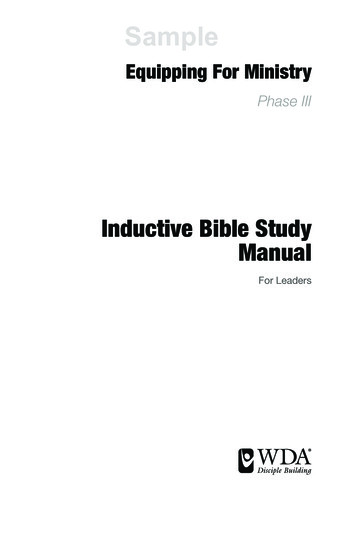
Transcription
SampleEquipping For MinistryPhase IIIInductive Bible StudyManualFor Leaders
SampleInductive Bible Study Manual, Equipping For MinistryCopyright 2005-2017 by Worldwide Discipleship Association, Inc.All rights reserved. No part of these documents may be used or reproducedin any form or by any means without prior written permission of WorldwideDiscipleship Association. These documents may not be changed in any wayor distributed for profit.For copyright information contact:Attention: Margaret GarnerWorldwide Discipleship AssociationP.O. Box 142437Fayetteville, GA 30214 USAE-mail: mgarner@disciplebuilding.orgWeb Site: www.disciplebuilding.orgScripture quotations, unless otherwise indicated, are from THE HOLY BIBLE,NEW INTERNATIONAL VERSION , NIV Copyright 1973, 1978, 1984, 2011by Biblica, Inc. Used by permission. All rights reserved worldwide.The following Bible version is also used:Scripture quotations marked (NASB) are taken from the New AmericanStandard Bible , Copyright 1960, 1962, 1963, 1968, 1971, 1972, 1973, 1075,1977, 1995, by the Lockman Foundation. Used by permission.NOTE: In an effort to recognize that both men and women are co-heirs of God’sgrace, we have chosen to use alternating gender pronouns in this document.However, we do recognize and embrace gender-specific roles in Scripture.Development & Writing Team:Margaret GarnerJack LarsonMargo TheivagtPublishing Team:Nila DuffittBuddy EadesMargaret GarnerDavid ParfittInductive Bible Study Manual L 01.31.2018Graphic Design: Cristina van de Hoeve · doodlingdesigner.com
A Welcome from WDA’s PresidentWorldwide Discipleship Association, Inc.Hello Friend!Let me congratulate you on your decision to learn more aboutministering to others in the name of Jesus Christ. This decision iscritical in your continued growth as a disciple.One of the most valuable skills a Christian can develop is theability to study the Word of God for ourselves and to apply it inour own life. The method of inductive Bible study offers suchan opportunity. This method is an effective, practical way ofarriving at the meaning and application of a Bible passage. Wein WDA want to help you grow as a disciple and become all youcan be in Christ Jesus!My prayer and confident belief is that “he who began a goodwork in you will carry it on to completion until the day of ChristJesus” (Philippians 1:6) so that He is able “to present you beforehis glorious presence without fault and with great joy.” (Jude1:24) To Him be glory and praise!May God richly bless you as you strive to grow in Him.Bob DukesPresident, Worldwide Discipleship Association, Inc.Fayetteville, GA 30214
SampleInductive Bible Study ManualTable Of Contents: Leader1Introduction5Motivating Objectives7Instructions To Leader10Suggested Assignments13Inductive Bible Study Teaching Outline21Directions For Doing An Inductive StudyDo a Background StudyObserve PassageInterpret MeaningApply Truth25Sample Background Study (Acts)27Sample Background Study (John)30Sample Inductive Study (Acts 8:26-40)32Sample Inductive Study (Acts 17:22-31)34Inductive Bible Study Guide (Blank)(historical passage)(teaching passage)Student WorkbookA complete copy of the Student WorkbookWhat's Next?About WDAIMPORTANT: Along with this Manual, you need to purchase(or have access to) the book How to Understand Your Bible byT. Norton Sterrett (1974 Edition) (InterVarsity Press). Studentsneed to have access to this book also. The Inductive Bible StudyStudent Workbook is included in this Manual.
SampleIntroduction(Content is similar to the Student Workbook, page 1, withspecial notes to the Leader.)One of the most valuable skills a Christian can develop is theability to study the Word of God for himself and to apply it inhis own life. The method of inductive Bible study offers suchan opportunity. This method is an effective, practical way ofarriving at the meaning and application of a Bible passage. Tomake it easy to follow, a numbered guide has been designedand is supplied at the back of this booklet. When a student usesthis method with a few passages of Scripture, he will “catchonto” the method and will be able to use the guide easilywithout the instructions.What is inductive Bible study? The word “inductive” refersto the way we process information and come to conclusions.When we think inductively we begin with specific facts anddetails and then draw general conclusions (interpretations andapplication) from those details. When we apply this type ofthinking to Bible study, we observe the facts of a passage andthen derive general principles from those facts. This involvesstudying the background of the passage, considering thecontext, understanding the words and grammar, and graspingthe author’s intention.This study method may be used for private devotions, for aleader’s preparation of a Bible study, for a small group’s studytime together, or for group member’s individual preparationbefore a meeting. A group leader may wish to supplement thestudy with his own lecture or discussion questions. Inductivestudies are especially effective in groups where people can1
Sampleshare their insights, research and application, and where leaderscan hold members accountable for completing the study. It isrecommended that a group be kept to twelve people or less. (SeeA Small Groups Manual, WDA.)The passages chosen for study in this workbook focus onevangelism, a theme in Phase III. After completing thesepassages, students may go on to a passage of your own choosingif they need more practice. A well-outlined study Bible canbe helpful. The New International Version (NIV published byZondervan) has excellent paragraph and idea divisions.A word about commentaries needs to be added here. Whilecommentaries (an in depth study of scripture) are useful tools,it is important for the Bible student to do her own study of apassage before reading a commentary. This encourages thestudent to do the mentally and spiritually challenging work ofstudying and allows the Holy Spirit to reveal truth directly tothe student. After a study is complete, it can be helpful to readseveral commentaries to investigate different viewpoints.We also need to comment on the different types of Bibles. Thereare two basic kinds of Bibles: translations and paraphrases.Translations are Bibles which are translated from the originallanguages, and there are many of them. Some translations arewritten by individual scholars and some by a committee ofscholars. Generally, the ones authored by committee are betterbecause there are more checks and balances in operation.Usually it is best to use a modern translation because it is easierto understand; however, the King James Version (KJV) is still verypopular. Two good recent translations are the New AmericanStandard Bible (NASB) and the New International Version (NIV).The NIV is the easier to read and understand of the two.2
SampleA paraphrase is not a translation. The author writing aparaphrase begins with a translation and puts the ideas intohis own words. Some popular paraphrases are Good News forModern Man, The Living Bible and The Message.The value of a paraphrase is that it makes difficult passages andcomplex sentences much easier to understand. The drawback isthat the reader is receiving another person’s interpretation of thepassage, and this may interfere with the reader developing herown point of view. For that reason, when doing inductive Biblestudy, it is best to begin with a translation. After doing yourstudy, a paraphrase can help you get another opinion aboutwhat the passage means. It is best to form your own opinionsfirst and then let others argue against them.3
SampleMotivating ObjectivesOf An Inductive Bible Study1. A disciple will learn a systematic approach to a limitedpassage of Scripture (one chapter or a section of eight or tenverses) and learn how to accurately, more fully understandwhat it teaches.2. A disciple will better understand what is in the Bible becauseit is studied in more depth.3. A disciple will prepare to study a whole book of the Bible bylearning to separate it into its parts and interpret them.4. A disciple will learn how to think through applications ofScripture after having interpreted it.5
SampleInstructions To LeaderInductive Bible StudiesLesson preparation for these Equipping For Ministry (Phase III)Bible studies will take some time and effort on your part. Weprovide you with direction, tools and suggestions. Of course, asalways, make any changes necessary to use these materials inways that meet the needs of your disciples.On pages 10-11 of this Manual you will find a list of suggestedassignments. (The assignment pages for the student are foundon pages 12-13 of the Student Workbook.) We will use theseassignments as a guide for our instructions. Sessions #1, 2 and3 are explained in more detail below in order to help you andyour group get started.IMPORTANT: The book entitled How to Understand Your Bibleby T. Norton Sterrett (1974 Edition) (InterVarsity Press) will beused with this Manual and the Student Workbook. This book hasbeen in print for years and is an excellent resource for the personwho is learning Bible study principles. Disciples who are beingtrained in ministry need to have this book in their library. Besure your students have a copy of this book or have access to it.Overall Goals: For a disciple to be prepared to do a background study on abook of the Bible independently. For a disciple to be able to complete an inductive Biblestudy independently. For a disciple to begin to understand basic hermeneuticprinciples.7
SampleSESSION #1Content and Resources for the Leader:Present the information in the Teaching Outline entitled“Inductive Bible Study” (page 13) at this first session. (TheTeaching Outline is not included in the Student Workbook.)Assignments Given to Students for Session #2:From Assignment sheet: Read Chapter 11 in How to Understand Your Bible. Do a background study on Acts. (Look at the sample aftercompleting the background study.) (Be sure that studentscan locate the sample in their Workbook on pages 15-16.)SESSION #2Goals: For disciples to report on their background studies. For disciples to observe a demonstration of completing theObservation column in the Inductive Bible Study (IBS) Guide.Content and Resources for the Leader: Discuss the background studies the students did on Acts. Discuss Chapter 11 of How to Understand Your Bible. Demonstrate doing the Observation column on the IBSGuide. Use Acts 8:26-40.NOTE: At the end of this Manual and at the end of theStudent Workbook there are sample inductive Biblestudies for students to learn from. Also, there is a blankInductive Bible Study Guide that may be reproduced. Adownloadable pdf of the blank Guide can also be foundat ols/inductive-bible-study-guide-pdf/.8
SampleAssignments Given to Students for Session #3:From Assignment sheet: Read pages 1-10 of Student Workbook. Read Chapter 10 of How to Understand Your Bible.SESSION #3Goal: For the disciple to observe an inductive Bible study beingdone.Content and Resources for the Leader: Review and complete the IBS Guide on Acts 8:26-40 whilethe students are observing. Discuss How to Understand Your Bible Chapter 10.Assignment to Students: See Assignment Page (pages 12-13 ofStudent Workbook)SESSIONS #4-8For the remainder of the assignments, continue following theAssignment Page. The format remains the same: A studentcompletes the inductive Bible study on the assigned passageduring the week, and then discusses the passage in the groupsetting. The student also participates in a discussion of theassigned portion of How to Understand Your Bible.Group sessions consist of discussions which center on thetruth focused on in the passage, as well as on the mechanicsand principles of inductive Bible study. The reading in How toUnderstand Your Bible begins acquainting the student with goodhermeneutic principles.9
SampleInductive Bible Study AssignmentsTeaching SessionSession #1 What is IBS?(Use Teaching Outline pg. 13) How to do background study Types of Bibles (study Bible,translations, etc.)Session #2 Discuss background study ofActs Discuss Chapter 11 in UB Demonstrate doing theObservation column on the IBSGuide (Use Acts 8:26-40)Assignment for Next Session(given at end of session) Read How to Understand YourBible, Chapter 11 Do background study onActs (author, date, purpose,occasion, outline of book).Look at sample after youcomplete the study. Read IBS Student Workbook,pages 1-10 Read UB Chapter 10 Do IBS on Acts 17:22-31 (w/olooking at sample at end of IBSStudent Workbook) Read UB Chapter 7Session #4 Review IBS on Acts 17:22-31 Discuss UB Chapter 7 Do IBS on Acts 2:22-36 Read UB Chapter 810Session #3 Demonstrate completing theIBS Guide on Acts 8:26-40during this session Discuss UB Chapter 10
SampleTeaching SessionSession #5 Review Acts 2:22-36 Discuss UB Chapter 8 Draw students' attention tobackground study on JohnAssignment for Next Session(given at end of session) Do IBS on John 3:1-15 Read UB Chapter 9Session #6 Review John 3:1-15 Discuss UB Chapter 9 Do IBS on John 4:7-26,39-42 Read UB Chapter 12Session #7 Review John 4:7-26,39-42 Discuss UB Chapter 12 Do IBS on John 8:12-30 Read UB Chapter 2Session #8 Review John 8:12-30 Discuss UB Chapter 2 NoneIBS: Inductive Bible StudyUB: How to Understand Your Bible, Sterrett11
SampleINDUCTIVE BIBLE STUDYTeaching OutlineSESSION #1Introduction:The Scriptures are one of the greatest assets that God hasgiven us to know Him and to discover His will.A. The Bible is part of special revelation. It tells us things thatwe could not know without its help, especially about God,His will and salvation.1. We learn much from general revelation, which includeseverything we can learn from observation, experienceand study in this world.2. But we need a filter (worldview) through wh
What is inductive Bible study? The word “inductive” refers to the way we process information and come to conclusions. When we think inductively we begin with specic facts and details and then draw general conclusions (interpretations and application) from those details. When we apply this type of
